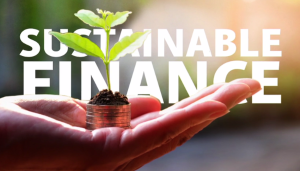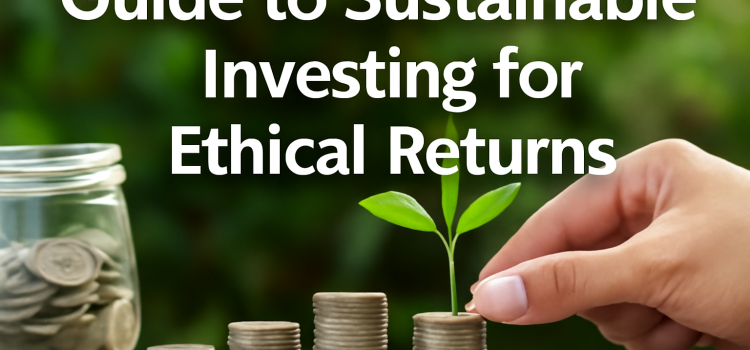
Introduction
In today’s world, many people want their investments to make a difference. Sustainable investing is a way to invest in companies that focus on protecting the environment, supporting communities, and making the world a better place. It’s no longer just about making money—it’s about making sure your money helps create positive change.
In 2025, sustainable investing is becoming more popular as more people understand its benefits. Whether you are new to investing or an experienced investor, this guide will help you learn how to invest for ethical returns. We’ll explain what sustainable investing is, why it matters, and how you can get started with it.
What is Sustainable Investing?
Sustainable investing means putting your money into companies or projects that focus on more than just making profits. These investments consider how businesses treat the environment, society, and their workers. Sustainable investing often includes:
- Environmental Impact Investing: Investing in companies that help reduce pollution, use renewable energy, or protect natural resources.
- Socially Responsible Investing (SRI): Choosing companies that are fair and responsible. These companies avoid harmful industries, like tobacco or weapons, and support good causes, like education and healthcare.
- Impact Investing: This focuses on projects or companies that aim to solve social or environmental problems, while still making a profit.
- ESG Investing: ESG stands for Environmental, Social, and Governance. It’s about investing in companies that are doing well in these areas—protecting the environment, treating people fairly, and being honest and transparent.
Why Sustainable Investing is Important

Sustainable investing isn’t just good for the world—it’s also good for you as an investor. Here’s why it’s important:
- Positive Impact: Your money can help companies that are doing good for the environment and society. For example, you could support companies working to stop climate change or improve access to clean water.
- Better Long-Term Returns: Studies show that companies that care about sustainability often perform better in the long run. These companies are more likely to avoid risks like environmental damage or poor treatment of workers, which can harm their business.
- Investing with Purpose: Many people want their investments to match their values.
- Changing Global Regulations: Around the world, governments are making stricter rules to protect the environment and encourage ethical business. These rules will likely benefit companies that are already focused on sustainability.
Types of Sustainable Investments

There are several types of sustainable investments you can consider. Here are a few of the most popular ones:
1. Sustainable Stocks
Investing in individual sustainable stocks means putting your money into companies that focus on protecting the environment or benefiting society. For example, you might invest in a company that makes solar panels or electric cars.
Example: Companies like Tesla (electric cars) or NextEra Energy (renewable energy) are examples of sustainable stocks.
2. Green Bonds
Green bonds are loans that companies or governments take out to fund environmental projects. For example, they might use the money to build wind farms or reduce pollution. These bonds are a way to invest in green projects that help the environment.
Example: Some countries or cities issue green bonds to fund clean energy projects.
3. Sustainable Mutual Funds and ETFs
Mutual funds and ETFs (exchange-traded funds) are like baskets of different stocks or bonds. You can find funds that only invest in companies that meet certain sustainability standards. These funds are a great way to invest in sustainable businesses without having to choose individual companies.
Example: The iShares MSCI KLD 400 Social ETF is a popular ETF for socially responsible investing.
4. Impact Investments
Impact investments are meant to generate positive social or environmental outcomes alongside financial returns. These could be investments in things like affordable housing, clean energy, or healthcare.
Example: Investing in a company that provides clean water to people in developing countries would be considered impact investing.
How to Start Sustainable Investing

If you want to start sustainable investing, here are some simple steps to follow:
1. Think About Your Values
The first step in sustainable investing is deciding what matters most to you. Are you passionate about the environment? Do you want to help improve social equality? Knowing your values will help you pick the right investments.
2. Do Your Research
Once you know your values, it’s important to research companies and projects that match them. Look for companies that focus on sustainability and have good ESG practices. You can also find funds that specialize in sustainable investments.
There are several websites and ratings agencies, like Sustainalytics and MSCI ESG Research, that can help you evaluate companies based on their environmental, social, and governance performance.
3. Choose Your Investment Tools
You can invest in stocks, bonds, mutual funds, or ETFs. If you’re new to investing, mutual funds and ETFs are good options because they allow you to invest in many companies at once, which helps reduce risk. If you prefer to invest in individual companies, you can look for those that meet your sustainability standards.
4. Diversify Your Portfolio
It’s important not to put all your money into one investment. By diversifying—investing in different types of assets or sectors—you reduce the risk of losing money if one investment doesn’t do well. Sustainable investing is no different. Spread your investments across different sectors like renewable energy, social enterprises, and green bonds to help balance risk.
5. Stay Informed and Monitor Your Investments
Sustainable investing is an ongoing process. As new companies and projects emerge, keep an eye on how they are performing and whether they still align with your values. It’s important to regularly review your portfolio to ensure your investments are still doing good for the environment and society.
Risks of Sustainable Investing
While sustainable investing is a great way to support your values, it comes with some risks. These include:
- Market Risk: Like all investments, sustainable investments are affected by market changes. They can go up or down in value based on the market, even if the company is environmentally responsible.
- Performance Risk: Some sustainable companies may have slower or lower returns than traditional investments, especially in the short term. It’s important to be patient and think about the long-term goals.
- Limited Options: Although there are more sustainable investment options now, they can still be harder to find compared to traditional investments. It may take extra effort to find the best options for your portfolio.
Benefits of Sustainable Investing

Positive Impact on Society and the Environment
Sustainable investing lets you help important causes. You can fight climate change, support fair labor practices, and promote good business governance. By investing in the right companies, you help make the world a better place.
Better Long-Term Returns
Many studies have shown that companies that follow strong ESG practices often perform better over time. These companies tend to be more stable, with less risk of facing financial or reputational damage. Investing in these companies can lead to better long-term returns.
More Transparency and Accountability
As the demand for sustainable investing grows, companies are becoming more transparent about their ESG practices. This gives investors more information to make informed decisions about where to put their money.
Lower Risk
Sustainable investments can reduce risk. Companies that focus on sustainability and governance are less likely to face major legal, environmental, or social issues. By investing in these companies, you are supporting businesses that are likely to be more stable in the future.
Support for Innovation
Sustainable investing supports the growth of innovative industries like renewable energy and green technology. By investing in these areas, you support innovation and encourage businesses to create new solutions for global issues.
Table: Sustainable Investment Options
| Investment Type | Description | Examples | Risk Level |
|---|---|---|---|
| Sustainable Stocks | Investing in companies that focus on sustainability | Tesla, NextEra Energy, Vestas | Moderate |
| Green Bonds | Bonds issued to fund environmental projects | Green Bond ETFs, Government-issued Bonds | Low |
| Mutual Funds & ETFs | Funds focused on ESG criteria and sustainability | iShares MSCI KLD 400 Social ETF, Vanguard ESG U.S. Stock ETF | Moderate |
| Impact Investments | Investments aimed at creating measurable social and environmental impact | Renewable energy projects, Social enterprises | High |
Conclusion
Sustainable investing offers a powerful way to earn returns while supporting causes you care about. Whether you’re focused on the environment, social justice, or good governance, there are plenty of opportunities to invest in companies that align with your values.
As more companies and funds focus on sustainability, the options for ethical investing will continue to grow. By starting now, you can make a positive impact and ensure that your money helps create a better world. Remember to choose investments that reflect your values, do your research, and diversify your portfolio to reduce risks.










